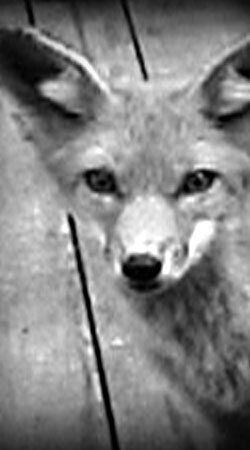
Urban Fox Project
1991My parents bought their house in Toronto's beaches area 43 years ago. It has a steep backyard with an undeveloped wooded zone across the top and neighbouring properties, connected to a network of ravines in the area. Urban foxes, being nocturnal, seek safe resting places for the day, often in the sheltered yards of elderly people. Between 1999 and 2001, my parents' trimmed shrubs became a locus for them. As many as nine appeared in the yard at one time, and I videotaped them. Many have since succumbed to the disease called sarcoptic mange. Last fall, foxes were sighted only rarely in the area.
The Urban Fox Project is a continuing exploration of their presence and issues. It takes the form of both art and academic research, investigating technology and human/animal embodiment. The Urban Fox Project draws on footage from my extensive archive of digital video of urban foxes, tracing peak population density in 1999-2000, through the decline in 2001 due to trapping and sarcoptic mange. The project includes the video animal Movies : fox past (2000) and the CD Rom fox : future (2001). Screenings for these projects include the Brooklyn Film Festival, Hot Docs, Pleasure Dome’s ‘Blueprint for Moving Images in the 21st Century, the Canadian Documentary Retrospective at the American Museum in Washington, the Planet in Focus Environmental Film Festival and Cinemateque Ontario
animal movies : fox past and fox : future were informed by the chapter Looking at the Non-Human in the book The Culture of Nature : North American Landscape from Disney to the Exxon Valdez by Alexander Wilson (1989). This chapter explores how animal movies and TV have impacted on ideas of nature.
The research and development of the Urban Fox Project is being carried out in the context of an Interdisciplinary Masters program at York University in Toronto. I am investigating how human-driven factors (including habitat change, public policy and representational discourses) effect the urbanization of wildlife (specifically, the red fox in the GTA). Alexander Wilson, among other writers, has analyzed how wildlife documentaries have shaped our interpretations of nature. Through the microcosm of a Toronto urban fox colony, I will examine how intersecting systems of representation impact on city life, and potential cultural responses using digital media.
I will research public policy effecting animals in the Greater Toronto Area, and in other cities. This policy research is informed by readings on science, ecofeminism, and the history of imaging technologies, including such authors as Rosi Braidotti, Catriona Sandilands, Elizabeth Grosz, Donna Haraway, N. Katherine Hayles and many others. Field research will be supervised by Leesa Fawcett, a biologist specializing in human/animal interactions. This research might include interviews with biologists, policy-makers, wildlife workers, animal rights activists and people dwelling in the proximity of urban wildlife. The profusion of urban fox web sites on the Internet, ubiquitous and shifting nature TV programming, and urban geographies are examples of pertinent representational systems for analysis.
